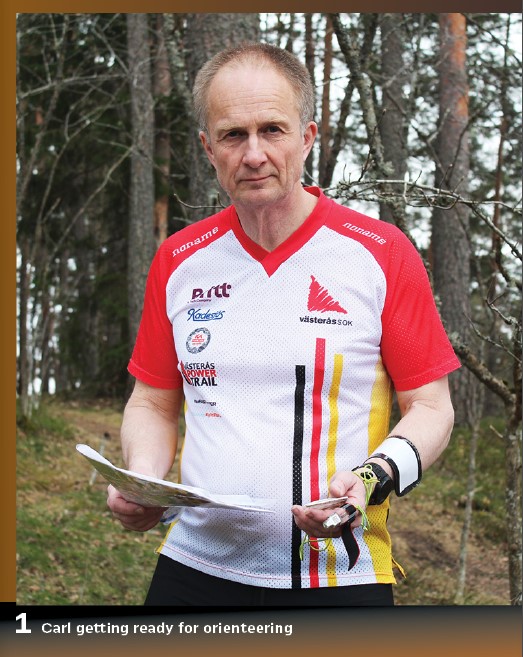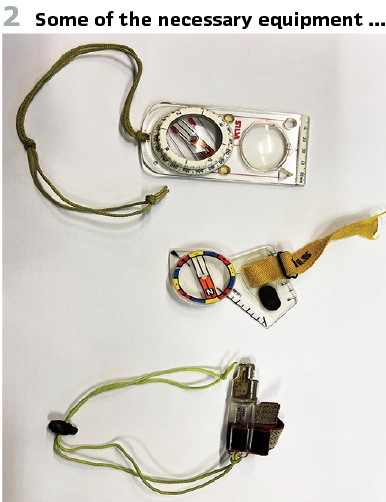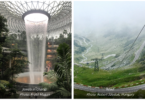by Carl Byman, Hitachi Energy, Sweden
At the age of ten my family moved to a new town, Vasteras, and I changed to a new school. In my new class there was an orienteer and I joined him to the practices. Now 50 years later, I still do orienteering!

Why orienteering?
I have always enjoyed nature. When I was young, we spent a lot of time in nature. We lived in Stockholm in the beginning, but we also had a small house in a village with 10 houses and the forest direct outside the garden. We spent a lot of time in nature, playing, walking, and skiing.
When I started with orienteering, I was the first in our family. But soon afterwards my parents realized that instead of just driving me to the practices and competitions, they could just as well participate themselves. We have always been out walking in the forest, but this opened up a new dimension. I think that orienteering is a perfect activity for the family. With a lot of discussions driving to the competitions, about anything, and the analysis after the race.
I also like that we are in nature and at different places. In most cases the competitions are in new places where I have never been and would never go to otherwise.
At competitions there are normally participants of all ages, from below 10 years to above 80 years, all sharing the same interest. These different generations are together in orienteering clubs and there are discussions between the generations, especially to analyze the races. Both my daughters started with orienteering at a young age, but only participate occasionally nowadays.
But maybe the best part is that each race is a new challenge. You never run the same course twice, so each time there are new challenges.
What is orienteering?
The basic idea is to find your way through any terrain. When it comes to competitions, it is to go through a course from start to finish in the shortest time with the help of a map and compass.

There are several variants of orienteering, but I only do foot orienteering:
- Foot orienteering, normally just called orienteering, is an endurance sport which involves a huge mental element. There is no marked route – the orienteer must navigate with map and compass while running
- The map gives detailed information of the terrain such as hills, ground surface, obstacles etc. To be successful in foot orienteering, the athlete needs excellent map reading skills, absolute concentration and the ability to make quick decisions on the best route
- Orienteers run over rough ground, completely unprepared forest terrain or rough open hills – cross country in the true sense of the word
- Ski Orienteering is an endurance winter sport combining navigation and cross-country skiing across a rough terrain using prepared cross-country ski tracks. A ski orienteer combines skiing with the ability to choose and follow the best routes
- Ski orienteers use a map to navigate in a dense network of ski trails and to visit control points in the predetermined order. Route choices are made on the basis of the quality of the ski tracks, gradient and distance, all of which can be read from the map
- Mountain bike orienteering is an endurance sport attracting both orienteering and mountain bike enthusiasts. The most important orienteering skills needed are route choice and map memory
- Mountain bike orienteers use a map to navigate in a dense network of trails and to visit control points in the predetermined order. Route choices are made on the basis of the quality of the trail tracks, gradient and distance, all of which can be read from the map
- Trail orienteering is an orienteering discipline centered around map reading in natural and urban terrain. The discipline has been developed to offer everyone, including people with limited mobility, a chance to participate in a meaningful orienteering competition equitably. Manual or electric wheelchairs, walking sticks, and helpers etc. are permitted when necessary for movement and speed over ground is not relevant for the competition
- The challenge is to identify the correct control marker from the information given by the map. This is done from a distance and mostly from a road or path, which make it possible for people with limited mobility to attend. Proof of correct identification of the control points does not require any manual dexterity, allowing those with severely restricted movement to compete equally. Most trail orienteering events have an O-class and a P-class, the O-class is open for all, and the P-class is for athletes with functional disadvantage due to a permanent mobility disability, who therefore cannot participate on reasonably equal terms in able-bodied foot orienteering
There are also different disciplines within the different variants. In (foot) orienteering there are:
- Long distance or even ultra long distance where there is a mixture of short and long distance between the controls. In this discipline the route choice becomes more important. Long distance is normally in the forest and for 60 years old men the course length is typically 5 – 7 km the shortest way between the controls
- Middle distance where the technical part and map reading is more important. Middle distance is normally in the forest and for 60 years old men the length is typically 3.5 km
- Sprint distance where the course is short, but it is easy to be tricked. Sprint distance is normally in an urban area where houses and fences create another dimension to the orienteering. For 60 years old men the course is about 2 km
- Night orienteering is maybe the most exotic discipline. A head lamp is needed, but otherwise it is similar to long distance

Equipment
To be able to do the course and show that you have been to all the controls there, some equipment is needed:
- Racing suit: This depends of course on the weather, but usually a lightweight suit that protects but allows full freedom of movement if it gets soaking wet. The forest can be both rough and wet
- Shoes: When running in the terrain the ground can be almost anything, from mud to bare cliffs. So, it is important to get a grip even if the terrain is wet
- Map: The map is provided by the organizer at the start. There is no time to prepare before the time starts. It describes the area in detail e.g., hills, stones, houses, open areas but also how good the visibility is and how easy it is to run in the area
- Compass: The compass helps to know the direction. One arrow points to the (magnetic) north pole. There are two main variants = thumb compass, that you stick to the thumb, and base plate, that you hold in the hand
- Control card: Is an electronic “pin” that must be punched at each control showing that all the controls are passed in the right order. Even the time when the controls are passed is stored in the pin

The course
An orienteering course consists of a number of controls (check points) that should be passed on the way from the start to the finish. There is no marked route to follow, only the map that shows where the start, the controls and the finish are.
In the competitions, time is what counts. Of course, all the controls must be passed in predetermined order on the way. To manage the course quickly there are a number of factors that are important.

- Choose the fastest way to the next control. It is not always the straight way between two controls that is the fastest. There could be rough forest in between and a nice trail to follow part of the way instead
- Following the selected way in the best route. It could be easy to run in the wrong direction
- The speed of running is important, but it is easy to make a mistake when you are tired. Also, to run in full speed and reading the map in the forest is not that easy, so it is important to balance the speed and the orienteering
Competitions
Competitions are arranged in different new places. Most other sports have their stadium or similar, but we need to build everything from scratch. In most cases it is done by tents or wagons, but it is considerable amount of work to get this in place.
There are some special competitions that are worth mentioning.
- O-ringen is a 5 days event in Sweden with people from around the world. The competitions are in different areas, but with a central place where people gather between the races. During this week a lot of people live together in a temporary camping ground. Last year’s competition gathered more than 15 000 orienteers
- Venla / Jukola is a relay in Finland with more the 18 000 orienteers. The women’s relay is during daylight, but the open relay starts in evening with some same legs during the night and some in the morning light. The women’s relay has four (4) legs and the men’s has seven (7) legs
- 25-manna is a relay in Sweden. The special part in this relay is that it comprises of 25 legs and there are rules for who can participate. It requires both genders and also that different ages participate in the teams. The different legs are also adjusted to fit the knowledge of participants on that leg
- There are also championships on different levels with the world championship on the top. The top countries shifts but the Nordic countries, (Sweden, Norway, Finland and Denmark), Switzerland and France are some of them, but other countries also have top athletes

Another dimension to the competitions is the analysis after the race. Everywhere after the race people are discussing route choices and mistakes. Even different generations share their experience.
This analysis starts directly after the finish and later on also back home with the family. It could even continue in the clubs later on to learn from each other. Nowadays there are also electronic aids for the analysis.
When I run, I have a watch that tracks my movement and afterwards this is uploaded to the Internet so everyone can see my route and compare it with other competitors.
As you have understood, orienteering is for life.

Nowadays there are “fun in the forest” groups for small children. The next step is a short, marked course in the forest passing controls, before the real orienteering starts.
The orienteering classes start from 10 years or younger to 95 years and older, even if there are not that many competitors over 95 years. Just imagine being 95 years old and still being able to find your way in the forest!
For me the orienteering is mainly to get out in the forest, the challenge, meeting with friends and keeping in shape. I hope I will be able to continue for many years to come.
Biography:

Carl Byman studied engineering physics at the University of Uppsala, Sweden and graduated 1989. Already before his studies he started working for ASEA and continued after his studies. ASEA had at this time merged with BBC and created ABB. Carl started with development of control system for substation. Working with protection started when the technology evolved, and communication was introduced in protection devices. During the last years ABB sold the transmission division to Hitachi and Carl is now working with development as part of Hitachi Energy.
Carl joined the IEC working group for protection functions in digital substation in 2019 and has been an active member since then. Since 2020 he is also the convenour of the Swedish mirror committee of TC95.








